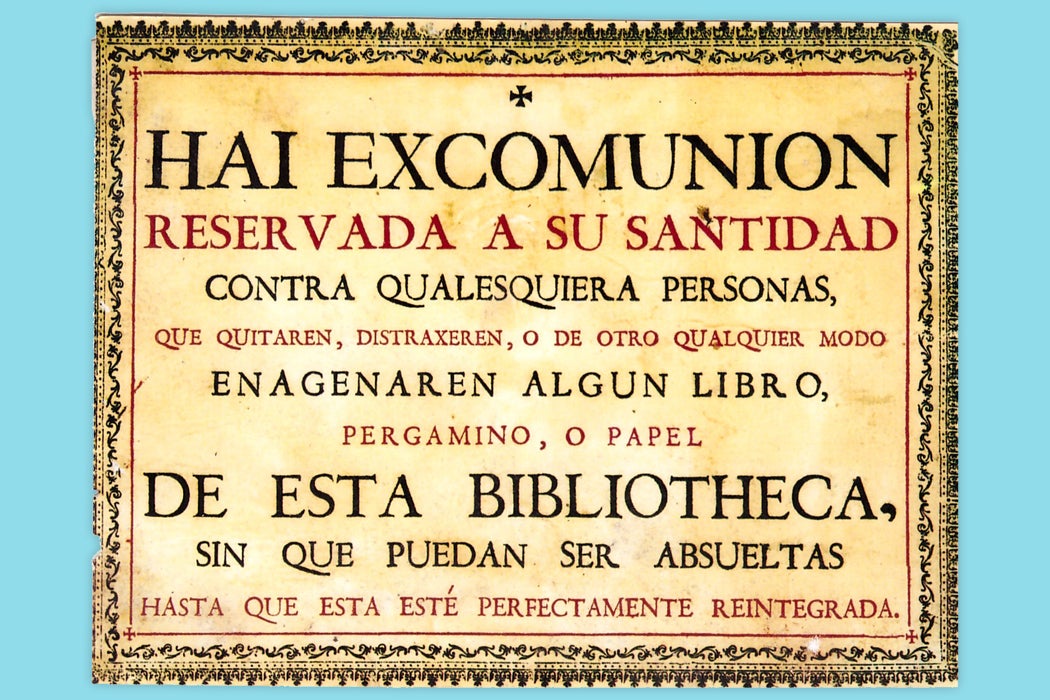A twelfth-century Bible came with a warning. “If anyone take away this book,” it began, “let him die the death; let him be fried in a pan; let the falling sickness and fever seize him; let him be broken on the wheel, and hanged. Amen.”
That’s a pretty serious warning. As media scholar Lauren Alex O’Hagan explains, books were a prized commodity, and the places that had them, such as the monastery that held this Bible, were considered prestigious. Scribes often inserted warnings into books and manuscripts, “threatening excommunication, damnation, or anathema to anybody who dared to loot them.” Though the invention of the printing press made books more available to more people, they remained irresistible to thieves.
As evidenced by the threatening inscription repeated above, the objects being stolen may be rare, but the crime is not. Book theft has been a problem for a long time. In fact, special collections librarian Travis McDade reports to Megan Cottrell for American Libraries magazine that “[i]t’s a crime about one day less old than libraries themselves.” Today, libraries of all sizes have had to come up with plans for protecting these materials.
“Any library that has a little collection that is unique or rare—a few items that relate to local history—all of those things are at risk,” McDade notes. Aside from the money that some of these materials are worth, why is book theft so widespread? It could be because of how and why we value books.
Historically, books were kept in high-status places, like monasteries, but by the early twentieth century, books were for everyone and everywhere. In England between 1901 and 1914, for example, “access to books was often a liberating and educational experience that helped [people] develop their personal identities and sense of self,” O’Hagan writes. And though free public libraries had been introduced in Britain in 1852, there was still a belief that books were not for working classes.
The early 1900s saw the start of a more widespread reading culture in the country, spurred by cheaper methods of bookmaking. But it was book ownership, not borrowing, that really changed things. Though they weren’t the luxury items they once were, “books began to be viewed as status indicators (due to their attractive decorative designs), emblems of pride (as personal possession was strongly linked to self-worth), or statements of intent,” O’Hagan explains.
This also meant that the kinds of books that people held dear were changing. As writer John Maxwell Hamilton points out, prior to the Industrial Revolution, “authorship was the province of economically self-sufficient elites.” You could write a book because you could do it on your own dime; not being paid somehow made the work purer. But when publishing became more accessible, writing as a profession also became more accessible, which meant that more readers were exposed to more voices—maybe even one that spoke to them like no other had before.
During this same period in the US, libraries “were never more vulnerable,” McDade writes in an essay about Pulitzer Prize winner and book thief, F. Lauriston Bullard. He attributes this vulnerability to
the terrific material lining [libraries’] open shelves and the fact that “Americana”—a broad area of collecting that included basically anything printed in or about the United States in the nineteenth century—was becoming a valuable commodity.
Though librarians have been on the front lines of many of history’s battles, they couldn’t be everywhere, watching everything. And book thieves knew it.
Weekly Newsletter
According to Hamilton, one would-be thief tried to slip Webster’s Unabridged Dictionary under her clothes and walk out of the library. She was thwarted when it fell out, a consequence of the book’s heft—it was six inches thick. Other book thefts are like most other heists: they’re inside jobs. One library’s janitor, tasked with cleaning the special collections room, went above and beyond, “pilfering historical artifacts and documents to sell for a profit.” And one well-known Lincoln scholar was also putting in time as a prolific book thief. One of his supporters blamed bibliomania, saying “his love of books must have turned his mind temporarily.”
Though our relationship with physical materials may have changed over the years, the value of these archives has not. As McDade writes, “It’s the stuff on which our history—our story—is written. Once they’re gone, they’re gone.”
Support JSTOR Daily! Join our membership program on Patreon today.







